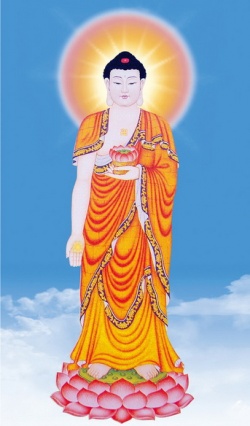Difference between revisions of "Kakuban"
(Created page with "thumb|250px| <poem> Kakuban [覚鑁] (1095–1143) Also known as Shokaku-bo. The precursor of the New Doctrine (Shingi) school in [[Ja...") |
|||
| Line 2: | Line 2: | ||
<poem> | <poem> | ||
[[Kakuban]] | [[Kakuban]] | ||
| − | [覚鑁] (1095–1143) | + | [[覚鑁]] (1095–1143) |
| − | Also known as [[Shokaku-bo]]. The precursor of the New Doctrine ([[Shingi]]) school in [[Japan]], a branch of the [[True Word]] ([[Shingon]]) school. Born in Hizen Province, he entered [[Ninna-ji temple]] in {{Wiki|Kyoto}} in 1107 and studied under [[Kanjo]]. He also studied at {{Wiki|Nara}} and received instruction in the True Word teachings at Kongobu-ji, Mii-dera, and Daigo-ji temples. He entered Kongobu-ji on Mount Koya in 1114. In 1132 he founded and presided over two new [[temples]] there, known as Daidembo-in and Mitsugon-in. In 1134 he concurrently became the chief priest of Kongobu-ji. This incurred the enmity of the other priests of {{Wiki|Mount Koya}}, however, and he and his followers were forced to flee. They went to Mount Negoro, where he founded Emmyo-ji temple. Because of differences in doctrinal interpretation, his followers founded the New Doctrine branch of the [[True Word]] school in the late thirteenth century, in opposition to the traditional teachings of Mount Koya and To-ji temple in {{Wiki|Kyoto}}. Those traditional [[temples]] and their teachings came to be known as the [[Old Doctrine]] ([[Kogi]]) school. | + | Also known as [[Shokaku-bo]]. The precursor of the [[New Doctrine]] ([[Shingi]]) school in [[Japan]], a branch of the [[True Word]] ([[Shingon]]) school. Born in Hizen Province, he entered [[Ninna-ji temple]] in {{Wiki|Kyoto}} in 1107 and studied under [[Kanjo]]. He also studied at {{Wiki|Nara}} and received instruction in the [[True Word]] teachings at [[Kongobu-ji]], [[Mii-dera]], and [[Daigo-ji]] [[temples]]. He entered [[Kongobu-ji]] on [[Mount Koya]] in 1114. In 1132 he founded and presided over two new [[temples]] there, known as [[Daidembo-in]] and [[Mitsugon-in]]. In 1134 he concurrently became the [[chief priest]] of [[Kongobu-ji]]. This incurred the [[enmity]] of the other {{Wiki|priests}} of {{Wiki|Mount Koya}}, however, and he and his followers were forced to flee. They went to [[Mount Negoro]], where he founded [[Emmyo-ji]] [[temple]]. Because of differences in [[doctrinal]] interpretation, his followers founded the [[New Doctrine branch]] of the [[True Word]] school in the late thirteenth century, in opposition to the [[traditional]] teachings of [[Mount Koya]] and [[To-ji temple]] in {{Wiki|Kyoto}}. Those [[traditional]] [[temples]] and their teachings came to be known as the [[Old Doctrine]] ([[Kogi]]) school. |
</poem> | </poem> | ||
{{R}} | {{R}} | ||
[http://www.sgilibrary.org/search_dict.php?id=1135 www.sgilibrary.org] | [http://www.sgilibrary.org/search_dict.php?id=1135 www.sgilibrary.org] | ||
[[Category:Shingon]] | [[Category:Shingon]] | ||
Latest revision as of 18:30, 16 April 2014
Kakuban
覚鑁 (1095–1143)
Also known as Shokaku-bo. The precursor of the New Doctrine (Shingi) school in Japan, a branch of the True Word (Shingon) school. Born in Hizen Province, he entered Ninna-ji temple in Kyoto in 1107 and studied under Kanjo. He also studied at Nara and received instruction in the True Word teachings at Kongobu-ji, Mii-dera, and Daigo-ji temples. He entered Kongobu-ji on Mount Koya in 1114. In 1132 he founded and presided over two new temples there, known as Daidembo-in and Mitsugon-in. In 1134 he concurrently became the chief priest of Kongobu-ji. This incurred the enmity of the other priests of Mount Koya, however, and he and his followers were forced to flee. They went to Mount Negoro, where he founded Emmyo-ji temple. Because of differences in doctrinal interpretation, his followers founded the New Doctrine branch of the True Word school in the late thirteenth century, in opposition to the traditional teachings of Mount Koya and To-ji temple in Kyoto. Those traditional temples and their teachings came to be known as the Old Doctrine (Kogi) school.
